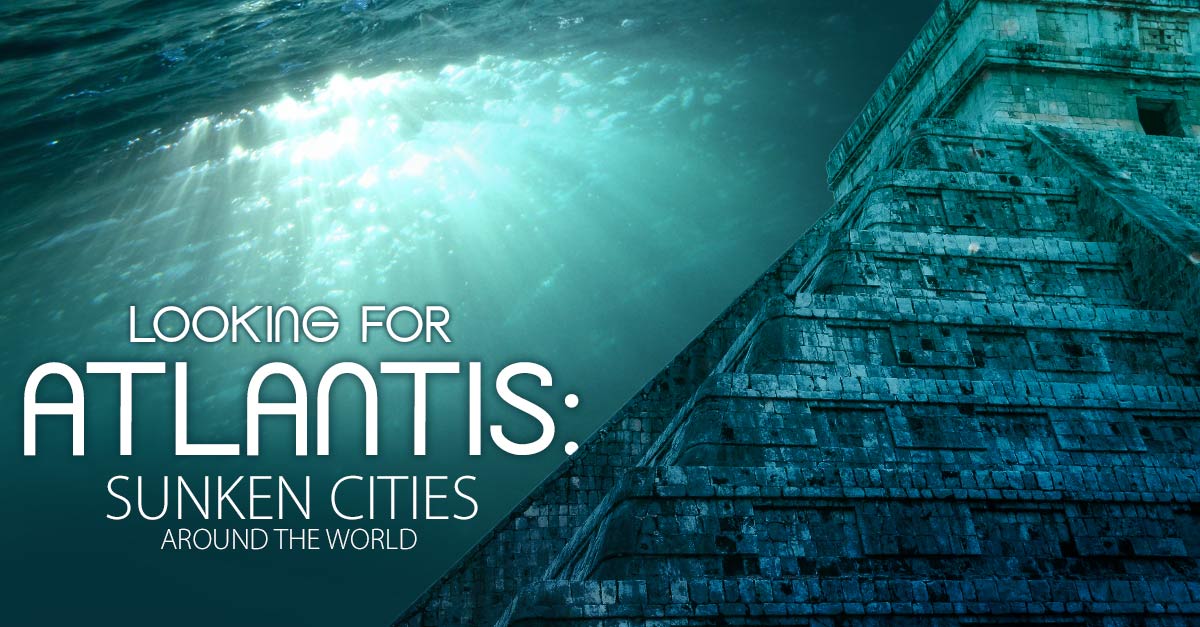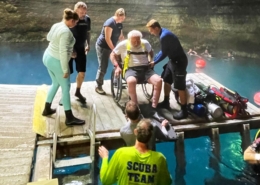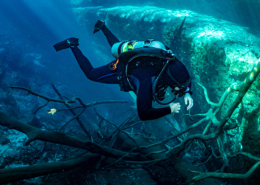Looking for Atlantis – Sunken Cities Around the World
By Gemma Smith
The Greek philosopher Plato wrote in 360 BC of a mighty island ‘beyond the Pillars of Hercules’. This island supposedly disappeared under the waves in a violent earthquake. This mythical island was Atlantis. Whether real, totally fictional or perhaps inspired by a true event like the eruption of the Greek island of Thera, we will never know. Nonetheless, over the centuries Atlantis has fascinated both poets and archaeologists. Many real-life sunken cities are compared to it. To celebrate these underwater time capsules, here are some of the top sunken cities you can dive (and some you can’t!):
Is it or isn’t it? The Yonaguni Monument
Is it man-made? Is it natural? Or is it a combination of the two!? The fact is no one really knows. The Yonaguni Monument is an underwater formation of terraced stones and triangular shapes, rising 76m/250ft from the seabed off the coast of Japan. But what exactly is it? Japanese marine geologist Masaaki Kimura is sure the structures are man-made stepped monoliths from 2-3,000 years ago. Could it possibly be, as Kimura has suggested, a remnant of the mythical ‘Lost Continent of Mu’? On the other hand, Patrick Nunn, Professor of Oceanic Geoscience at the University of the South Pacific, believes otherwise. He is sure there is no evidence to suggest that it is other than the result of natural forces. While the jury is very much still out on its origins, it is a mecca for scuba divers. Maybe one day some sharp-eyed scuba diver will be the one to discover its true identity?!
The ‘Wickedest City in the world’- Port Royal, Jamaica
Located in the southeast corner of Jamaica, the natural harbour at Port Royal was the centre of English life on the island. Of course, the plunder brought in by English privateers/pirates helped! Jamaica lay on Spain’s route from its conquests in South America home to Europe. Its gold-laden ships were irresistible targets. And the English government got its share too! The city became notorious for its easy life of ‘wine, women, and song’.
However, the city’s luck ran out on the morning of 7 June 1692, when a massive earthquake drowned much of the city in moments. Unfortunately for the inhabitants, the building of much of Port Royal was on sand. Some 33 acres of the city disappeared underwater that day. Many at the time saw it as God’s judgment on the morals of Port Royal.
Today, most of the remains lie in up to 40m/130ft of water. Though, because of the cultural importance of the city, special access from the government is required to dive the site. Luckily you can still dive nearby though! Many of the artefacts from the doomed city are on display at the Museums of History and Ethnography. Included is a watch which stopped at the exact moment the earthquake struck! It is a macabre testimony to Port Royal’s destruction.
Imperial Splendour- Lion City of Quiandao Lake, China
The ancient Chinese city of Shi Cheng (Lion City) has been submerged in Qiandao Lake since the building of a reservoir and hydroelectric station in 1959. The breathtaking ruins lie between 85-130ft/26-40m below the surface of the lake, and visibility can be extremely poor. Torches are essential equipment! Yet the carvings on the buildings are just incredible. Despite their age of nearly 1400 years, they are in amazing condition. Dragons, phoenixes, and, of course, lions among other carved animals and plants loom out of the gloom of the lake as you approach the structures they adorn. Chinese letters are also carved into the stone of the buildings. Even remnants of trees from when the city was on dry land are visible! It is a truly awe-inspiring sight.
The Oldest Submerged City in the Mediterranean Sea – Pavlopetri
Off the coast of Laconia in Greece lies the remains of an almost 5,000 years old Ancient Greek city. Probably submerged by an earthquake around 1,000 BC, its buildings have long since crumbled. But we can still see the plan of the city, including streets, building plots, and tombs. Mapping of the site happened in 1968 by a team of archaeologists from Cambridge University. In 2009 a team from the University of Nottingham, in collaboration with the Greek government, did further surveys. This was in conjunction with researchers from the Australian Centre for Field Robotics.
The remains at Pavlopetri lie only 3-4 metres (about 10-13 feet) under the surface of the sea. As well as discovering the outlines of the city’s buildings, evidence of how its inhabitants lived is clear. Large pottery jars from Crete indicated the city’s importance as a trading centre. The many loom weights recovered also showed a thriving textile industry there.
It truly is a fascinating snapshot of an Ancient Greek city. Because the site is fragile and relatively shallow, diving happens only with masks and snorkeling gear.
A Neolithic Metropolis – Atlit Yam, Israel
Imagine the scene: marine archaeologist Ehud Galili is surveying for shipwrecks off the coast of Israel. Yet, to his astonishment, he discovers the remains of a 9,000-year-old Neolithic town! Covering over 40,000 square metres (43,000 square feet) the 8-12m/25-40 feet site contains remnants of houses, stone-walled wells, tombs, and even a submerged stone circle! This circle consists of seven 600- kilogram (1300 lb) megaliths grouped around a stone well. This well contained plant and animal remains, flint, and stone artefacts. The megaliths were even incised with so-called ‘cup marks’. There is speculation that the megaliths and well were part of a water ritual of some kind. Among other things found were bone fish hooks and stone arrowhead, sickle blades, and axes. Archaeologist have also found dozens of sets of human remains.
No one is quite sure why the city was abandoned. Maybe it was a tsunami caused by an eruption of Sicily’s Mount Etna? Or a rise in sea level due to melting glaciers? Whatever the cause, it has left us with stunning insights into the lives of some of our early ancestors.
Holidaying with Caesar – the Underwater Archaeological Park of Baia, Italy
Anybody who was anybody in the early Roman Empire, holidayed at Baiae (in modern Italian, Baia). From emperors to wealthy entrepreneurs, this was the place to be. The town boasted temples, baths, parks, and the most luxurious villas that money could buy. Baiae became a byword for extravagance, corruption, and scandal among the Roman elite. One ancient writer described Baiae as a ‘harbour of vice’. Julius Caesar, Nero, and the emperor Claudius all had villas there. Much of this is still seen above ground, and in the nearby museum. The lower part of the town became submerged due to local volcanic action from the nearby Vesuvius.
However, underwater archaeology has revealed this lost landscape. Many remnants of those once luxurious villas are now protected in an underwater park. Guided dives allow the public to once again marvel at the Roman genius, both for building, and for extravagance of course! There are structural ruins of gardens, arcades, houses. There is even a nymphaeum (a shrine or grotto dedicated to a nymph or nymphs)! We can see remains of the ancient Portus Julius. Mosaic floors emerge to wonder at. Seeing the bubbling fumaroles testify to the volcanic nature of the area. These remains are an intriguing glimpse into an ancient society and culture.
The Gateway to Ancient Egypt- Thonis-Heracleion
Some cities, like Atlantis itself, are more myth than reality. Others, once real, disappear in the mists of time. Such was the fate of one of ancient Egypt’s premier cities. The famous Greek hero Hercules (in Greek, Heracles) set foot there in legend and gave his name to the city (Thonis is its Egyptian name). Founded probably around the 8th century BC., it dominated worldwide trade for centuries. Yet over the years it was eclipsed by the city of Alexandria, founded by Alexander the Great. Its power in its prime was obvious though. In nearby waters was the discovery of more than 700 anchors of various types, and over 70 wrecks.
Yet, it disappeared beneath the sea and was half-forgotten for centuries. It wasn’t until surveys and excavations by the European Institute for Underwater Archaeology, led by Franck Goddio, in conjunction with the Egyptian Supreme Council of Antiquities, brought its treasures back into the light. And what treasures they are! Gold jewellery-rings, pendants, and earrings, life-size statues of gods and goddesses, both Egyptian and Greek, and statues of sphinxes, pharaohs, and their queens. The remains of a wooden ceremonial barge used in the annual religious procession of the Mysteries of Osiris was also recovered. There are smaller artefacts such as bronze ladles, ritual models of boats, and gold dedication plaques. All testify to the beauty and prosperity of the city.
So, what happened to almost erase this magnificent city from history? Built in the Nile delta, Thonis-Heracleion lay in an unstable area of part land, part sea. There was slow subsidence of the land due to movements of the earth’s crust. Also, the heavy temple buildings put excessive pressure on the underlying clay soils. Severe flooding and/or possible tsunami activity would have further stressed the area and caused collapse. At the end of the 2nd century BC the main buildings succumbed to liquefaction of the ground surface and sank. Possibly there was also earthquake activity. Towards the end of the 8th century A.D. the surviving remnants of the once-thriving city finally disappeared.
However, thanks to the expertise of Franck Goddio and the Underwater Institute, we can now rediscover the grandeur of this ancient city. In fact, archaeologists estimate that only a tiny portion of the site has been thoroughly researched. We have more thrilling discoveries to look forward to!
Atlantis of the Andes- Wanaku and Lake Titicaca
Up from the depths of Lake Titicaca rose Viracocha to make the sun, moon, stars, humankind and even time itself. So goes one version of the creation story of the fabled golden empire of the Incas. This large Andean lake, sometimes called the highest navigable lake in the world, has always drawn legends. These include stories of Inca gold looted and then lost by the Spanish conquistadors and of an ancient underwater city, ‘Wanaku’. In the late 1960s the famous oceanographer, Jacques Cousteau even explored the lake but found no gold, only ancient pottery. National Geographic launched an expedition into the lake in 1988 but without success.
But in 2000 a scientific expedition led by Italian Lorenzo Epis found the submerged ruins of a temple thought to be between 1000-1500 years old. The temple was big, measuring originally 200 x 50 metres (660 x 160 feet). There have been more than 200 dives into the lake to record the ruins and gather artefacts. There are even plans to erect a museum nearby to explain and research the site. This museum could even lie partly submerged so that visitors could see some of the remains discovered. Surely the ‘Atlantis of the Andes’ has still more secrets to offer up.
All around the globe, there are sunken cities waiting for discovery and exploration. From Phanagoria in the Black Sea to Dwarka off the northwestern coast of India, from rumoured remains of a city off the coast of Cuba to the submerged city of Dunwich, once the capital of the Kingdom of the East Angles in England there are plenty of mysterious cities at the bottom of the sea to research, explore and explain.










Tinggalkan Maklum Balas Anda
Ingin Berbincang Bersama?Kami Hargai Sumbagan Anda!